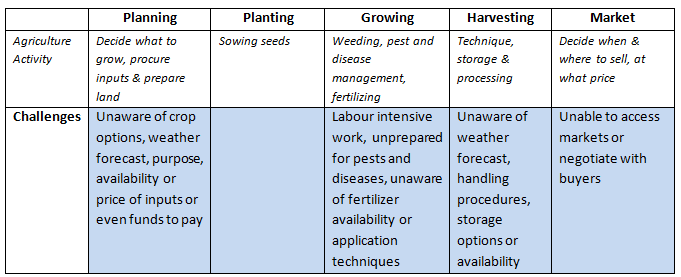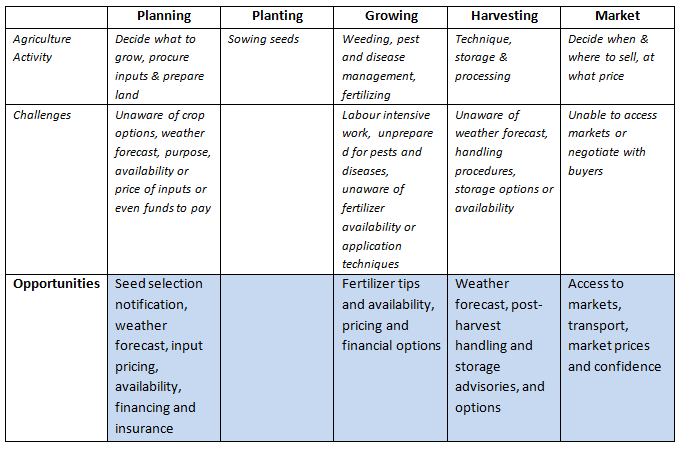Last week I participated in a design workshop hosted by Mercy Corps Agri-Fin and facilitated by Thoughtworks. Our objective was to brainstorm viable options for a mobile agriculture service targeting rural farmers in a Sub Saharan African country. Although this is an early stage commercial endeavour and most of the workshop activities are confidential, the following post (the first in a 3 part series) has been cleared to share with our readers.
We all understand that products and services must be designed for and around users; that’s simply a fundamental principle of products/service design. I think the questions and obstacles arise when we attempt to put those fundamental principles into action. Where does one begin?
The User Journey Approach
For our design workshop, our Thoughtworks facilitators used methods adapted from the “User Journey” approach to suit the specifics of the workshop goals. Rather than explain the concepts in this method, I’ll try to demonstrate a generic example. It’s important to note that a high degree of subject matter expertise on the intended users and their activity is needed for this exercise. Where that knowledge is absent, then careful research is needed to complete each step. In the case of our workshop, we had expert representatives from all target stakeholder groups (especially farmers).
Defining Personas
Our approach began with defining personas which are likely user profiles that represent our target audience. In our workshop we created multiple personas for the various stakeholders who would engage with a service (smallholder farmers, commercial farmers, dairy farmers, buyers, middle men, agri processors, male, female, etc.).
Personas should be detailed and realistic, however for the sake of this demonstration; I’m creating a new generic persona for a female smallholder named Hilda. She is 29 years old and lives in a rural village in sub Saharan Africa on a 2 hectare plot of land with her 3 children (ages 3, 5 and 9). Her husband left her to manage the plot while he works as a labourer in the regional city visiting once every 1-2 months. She grows maize, beans, cassava and potatoes in addition to a small family vegetable garden. They eat what they grow and sell the rest when possible; at times she trades the produce with neighbours. Typical expenses include school fees and periodic medical costs. Hilda wants to save up for chickens or goats. Although she is not very literate, Hilda has a mobile phone and uses it to answer calls from her husband and family members or receive occasional mobile money transfers from her husband.
Drafting a User’s Journey
We can now begin to draft Hilda’s journey through her agriculture related activities. This involves examining the key tasks Hilda conducts throughout her journey as a farmer. Drafting a Journey is best done on a calendar basis or the planting cycle, which I have chosen:
Other agriculture related activities to consider include paying school fees, health care costs, savings, etc.
Now that we have an idea of Hilda’s journey, we can begin to identify her challenges. What problems does she face through her journey? In the table, I’ve added the “Challenges” row:
Regarding her agriculture related activities, Hilda has few funds available and no access to credit for her expenses or saving opportunities.
Having well defined challenges now helps us to see the opportunities a new product or service can address.
Additional opportunities exist to offer Hilda financial literacy advisories and savings and lending schemes.
In my follow on blog post I’ll begin by discussing what product or service concepts can follow these opportunities and then explore the underlying business model and business case. Stay tuned!




